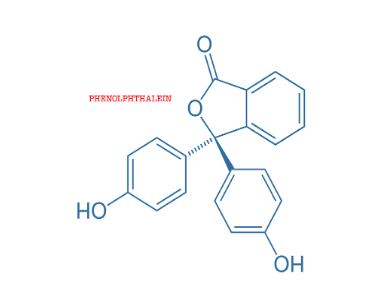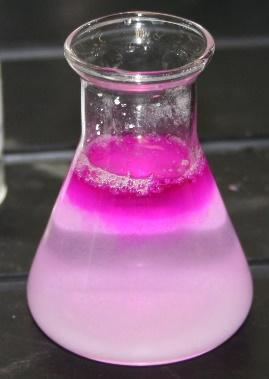Answer
78.3k+ views
Hint: Phenolphthalein is generally used as an indicator in acid–base titrations. It turns colourless when added to an acid and pink when added to basic solutions. Caustic soda is a strong base and will ionise more when phenolphthalein is added into it.
Complete step-by-step answer:
Caustic soda is a chemical compound named sodium hydroxide, NaOH. It is a strong alkali used in many things such as water treatment, metal processing, food, etc. It is also called Lye. It is corrosive in nature and has a wide range of applications. It is also used as a cleansing agent, in the production of washing soda. It can be prepared by many methods. One such method is the Castner-Kellner method. In this method, electrolysis of brine solution (aqueous NaCl) is performed in order to get sodium hydroxide.
Phenolphthalein is another chemical compound organically synthesised as \[{C_{20}}{H_{14}}{O_4}\]. It is used in laboratories as an acid-base indicator in various titrations performed. It is colourless below pH 8.5 i.e. in acidic solutions and attains a pink to deep red hue above pH 9.0 i.e. in basic solutions.

Therefore, when phenolphthalein is added to caustic soda which is a strong base, it turns pink in colour. This is because the compound in aqueous form has anions present in it. It is itself a weak acid and does not react with acid and thus remains colourless. But being a weak acid, it reacts with a strong base, resulting in partial dissociation of the base.

This is a true statement. Hence, the correct option is (A).
Note: Since it is a weak acid, it loses protons in solution form. It is less soluble in water and usually dissolved in alcohols when used in laboratories. In titration, it acts as an indicator that tells us the end point, a point where the reaction completes.
Complete step-by-step answer:
Caustic soda is a chemical compound named sodium hydroxide, NaOH. It is a strong alkali used in many things such as water treatment, metal processing, food, etc. It is also called Lye. It is corrosive in nature and has a wide range of applications. It is also used as a cleansing agent, in the production of washing soda. It can be prepared by many methods. One such method is the Castner-Kellner method. In this method, electrolysis of brine solution (aqueous NaCl) is performed in order to get sodium hydroxide.
Phenolphthalein is another chemical compound organically synthesised as \[{C_{20}}{H_{14}}{O_4}\]. It is used in laboratories as an acid-base indicator in various titrations performed. It is colourless below pH 8.5 i.e. in acidic solutions and attains a pink to deep red hue above pH 9.0 i.e. in basic solutions.

Therefore, when phenolphthalein is added to caustic soda which is a strong base, it turns pink in colour. This is because the compound in aqueous form has anions present in it. It is itself a weak acid and does not react with acid and thus remains colourless. But being a weak acid, it reacts with a strong base, resulting in partial dissociation of the base.

This is a true statement. Hence, the correct option is (A).
Note: Since it is a weak acid, it loses protons in solution form. It is less soluble in water and usually dissolved in alcohols when used in laboratories. In titration, it acts as an indicator that tells us the end point, a point where the reaction completes.
Recently Updated Pages
Name the scale on which the destructive energy of an class 11 physics JEE_Main

Write an article on the need and importance of sports class 10 english JEE_Main

Choose the exact meaning of the given idiomphrase The class 9 english JEE_Main

Choose the one which best expresses the meaning of class 9 english JEE_Main

What does a hydrometer consist of A A cylindrical stem class 9 physics JEE_Main

A motorcyclist of mass m is to negotiate a curve of class 9 physics JEE_Main

Other Pages
Chloroform reacts with oxygen in the presence of light class 12 chemistry JEE_Main

If a wire of resistance R is stretched to double of class 12 physics JEE_Main

Electric field due to uniformly charged sphere class 12 physics JEE_Main

The voltage of an AC supply varies with time t as V class 12 physics JEE_Main



